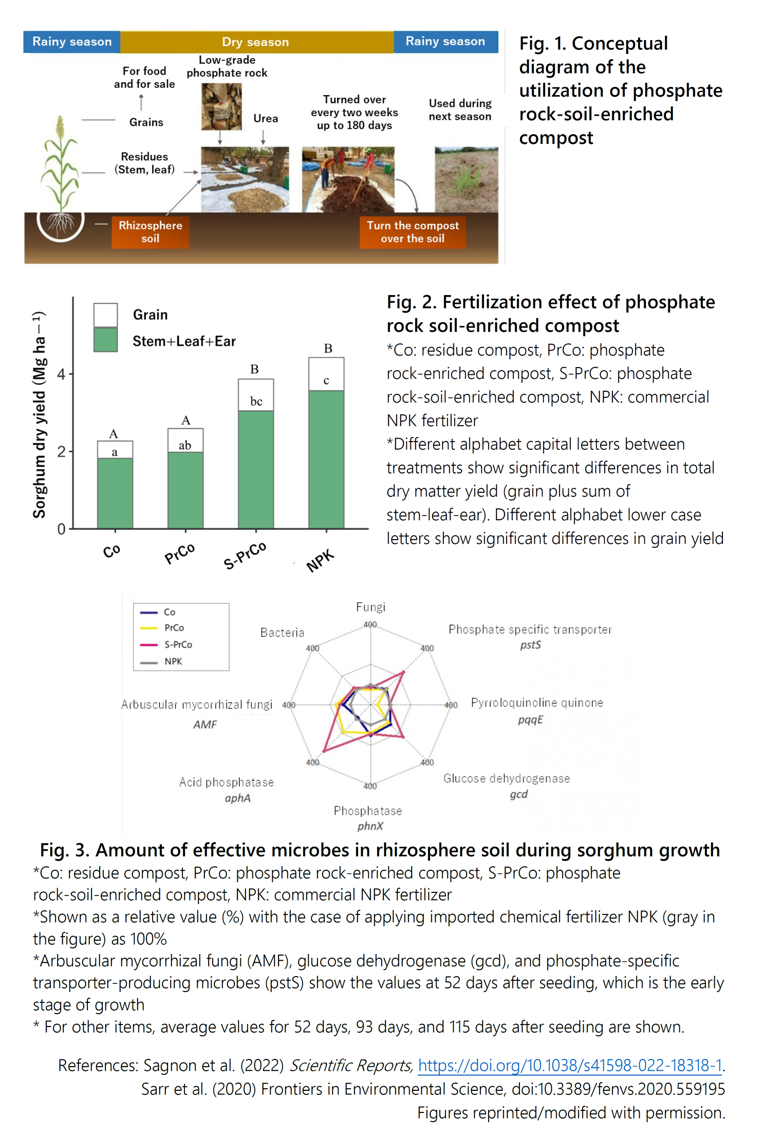Phosphate rock-enriched compost with rhizosphere soil increases sorghum yield equivalently to chemical fertilizers
Description
The limited availability of phosphorus in sub-Saharan African soils is a significant constraint to agricultural production. Cereal production in the area is only 1.59 tons per hectare, while the world average is 4.15 tons per hectare (World Bank, 2021). In view of the demographic trend showing high population growth in sub-Saharan Africa, increasing crop production by improving soil nutrient availability is of high priority. Unfortunately, the recent surge in the prices of chemical fertilizers complicates their effective use by smallholder farmers. Therefore, in a previous study, we formulated a new compost type by co-composting crop residue with low-grade phosphate rock and soil collected from the sorghum root rhizosphere area (S-PrCo). The rhizosphere soil, influenced by complex molecular exchanges between roots and microbes via root exudates, is generally rich in beneficial microbes, including phosphorus solubilizers. We included a phosphate rock-enriched compost without rhizosphere soil (PrCo) and compost with only crop residues (Co). All composts were made with 100 kg of sorghum straw as crop residue and 460 g of urea to reduce the C/N ratio from 55/1 to 25/1 and ease the decomposition. We added 10 kg of phosphate rock and 10 kg of rhizosphere soil where necessary. Each compost pile was arranged in five successive layers, the moisture content was adjusted to 65%, and the composting lasted 180 days (Fig. 1). The available phosphorus and phosphate-solubilizing microbes increased in S-PrCo.
The present study evaluated S-PrCo, PrCo, and Co on sorghum growth and soil properties compared to the chemical fertilizer NPK (nitrogen-phosphorus-potassium). The results showed that S-PrCo significantly increased sorghum dry matter (grain, stem/leaf/ear) compared to PrCo and Co and gave a yield equivalent to the chemical fertilizer (Fig. 2). S-PrCo also improved soil biological properties by increasing the population of arbuscular mycorrhizal fungi involved in the uptake and transfer of phosphorus to the roots. It also enhanced the abundance of P-cycling microbes, such as phosphate-solubilizing bacteria with the glucose dehydrogenase (gcd), acid phosphatase (aphA), phosphonatase (phnX), and phosphate specific transporter (pstS) genes as shown in Figure 3. The study clarified that the significant yield-increasing effect of the new compost type (S-PrCo) is not only due to the increase of available phosphorus in the compost prior to application but also due to the improvement of soil biological activity with the promotion of phosphorus solubilization and absorption during the cultivation period. S-PrCo also improves soil chemistry by correcting the soil pH. This research indicates that co-composting crop residues with low-grade phosphate rock and rhizosphere soil is expected to provide farmers in sub-Saharan Africa with a new fertilizer option against rising chemical fertilizer prices and soil degradation.
Figure, table
- Research project
- Program name
- Term of research
-
FY2017–2022
- Responsible researcher
-
Sarr Papa Saliou ( Crop, Livestock and Environment Division )
ORCID ID0000-0002-4478-4463Nakamura Satoshi ( Crop, Livestock and Environment Division )
ORCID ID0000-0002-0952-5618KAKEN Researcher No.: 00749921Iwasaki Shinya ( Rural Development Division )
ORCID ID0000-0002-5015-7837KAKEN Researcher No.: 40915261Tibiri Ezechiel Bionimian ( Environmental Institute for Agricultural Research, Burkina Faso )
Zongo Armel Nongma ( Environmental Institute for Agricultural Research, Burkina Faso )
Compaore Emmanuel ( Environmental Institute for Agricultural Research, Burkina Faso )
Tiendrebeogo Fidele ( Environmental Institute for Agricultural Research, Burkina Faso )
Traore Mamoudou ( Environmental Institute for Agricultural Research, Burkina Faso )
Sagnon Adama ( Joseph Ki-Zerbo University, Burkina Faso )
Barro Nicolas ( Joseph Ki-Zerbo University, Burkina Faso )
Bonkoungou Isidore Juste O ( Joseph Ki-Zerbo University, Burkina Faso )
- ほか
- Publication, etc.
-
Sagnon et al. (2022) Scientific Reports 12: 13945.https://doi.org/10.1038/s41598-022-18318-1Sarr et al. (2020) Frontiers in Environmental Sciencehttps://doi.org/10.3389/fenvs.2020.559195
- Japanese PDF
-
2022_B11_ja.pdf734.44 KB
- English PDF
-
2022_B11_en.pdf579.33 KB
* Affiliation at the time of implementation of the study.

